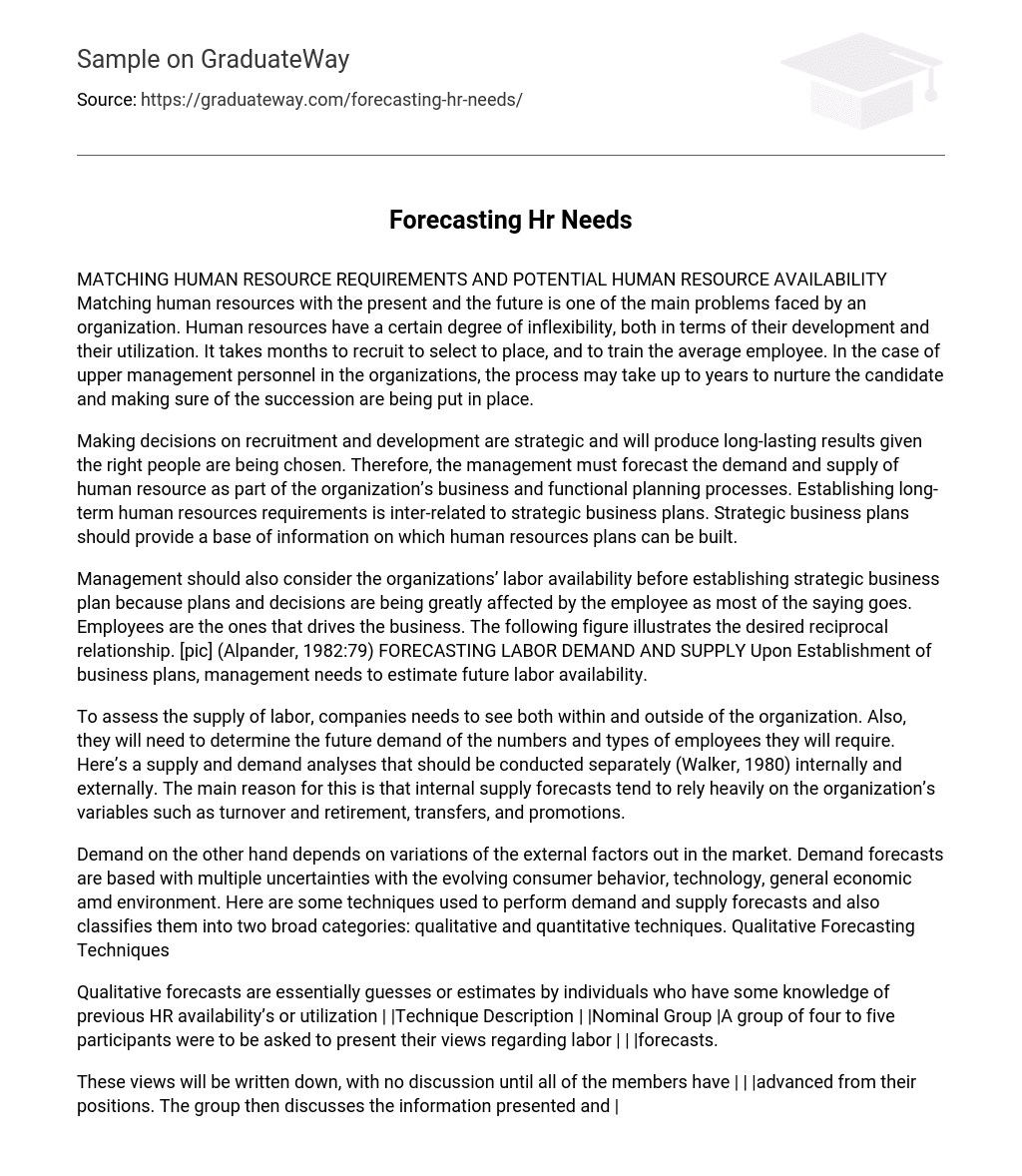Aligning human resources with current and future needs is a significant challenge for organizations. There is a level of inflexibility in terms of development and utilization of human resources. The average employee’s recruitment, selection, placement, and training can take several months. However, when it comes to upper management personnel, this process may extend to years in order to nurture the candidate and establish a clear succession plan.
Decisions pertaining to recruitment and development are crucial, as they can have far-reaching impacts if the right individuals are selected. Hence, it is essential for management to forecast the demand and supply of human resources as a component of the organization’s business and functional planning processes. Setting long-term human resource requirements is closely linked to strategic business plans, which should serve as a foundation for developing human resources plans.
Management should take into account the labor availability of the organization when creating a strategic business plan, as plans and decisions are heavily influenced by employees, who are commonly referred to as the driving force of the business. The accompanying figure depicts the intended reciprocal relationship. [pic] (Alpander, 1982:79)
FORECASTING LABOR DEMAND AND SUPPLY
Management must estimate future labor availability when establishing business plans. To evaluate the supply of labor, companies should consider both internal and external sources. Additionally, they need to anticipate the future demand for the quantity and types of employees needed. It is recommended to separately conduct supply and demand analyses within the organization and externally (Walker, 1980). This separation is essential because internal supply forecasts primarily depend on organizational variables like turnover, retirement, transfers, and promotions.
Demand forecasting depends on market external factors and involves uncertainties related to consumer behavior, technology, the economy, and the environment. There are various techniques used for demand and supply forecasts that can be classified as qualitative and quantitative methods.
Choosing a Forecasting Method
Forecasters can choose to use qualitative or quantitative techniques, or a combination of both, assuming that there is a relationship between labor supply and demand and a pattern. When selecting a forecasting technique, it is important to consider the following factors. These factors indicate that different organizations may adopt different approaches. By considering elements such as the organization’s environment and size, perceived uncertainty in labor markets and the economy, and competition, the Miles and Snow typology can help determine appropriate forecasting techniques for an organization.
HR SYSTEMS DEFENDER PROSPECTOR ANALYZER
Forecasting in defender organizations relies on stable and simple environmental conditions. Defenders typically operate in predictable product markets, face high barriers to entry, and experience minimal product variation. This enables them to engage in less environmental scanning and focus more on long-term forecasting and planning. Defenders can utilize advanced techniques like regression analysis to forecast labor demand and supply. Internal labor-market forecasts are given priority, allowing defenders to maintain a defensive stance by pursuing low-cost operations.
The success of defenders relies on their production efficiency and tight business controls. Defenders typically have highly specialized jobs within vertically differentiated units, resulting in a stereotypical bureaucratic structure characterized by formalization and specialization. On the other hand, prospectors operate in a dynamic environment with rapid advances in technology, product development, and market shifts.
In this organizational configuration, long-range forecasting and planning are challenging due to the rapidly evolving market and changing demands influenced by technology and the economy. The environmental constraints faced by prospectors further complicate short-term demand forecasting. Likewise, forecasting labor supply is equally difficult, leading to the utilization of qualitative techniques like nominal groups and the Delphi technique for labor demand and supply forecasts.
Prospectors, in their pursuit of innovation and adaptation, often operate in an inefficient manner, especially when compared to defenders. Their focus lies on investing in research and development, aiming to earn significant profits through the creation of uniquely designed products. To achieve this goal, prospectors must adopt a flexible organizational structure that avoids rigidities and inflexibility typically associated with formalization. Analyzers, on the other hand, incorporate traits from both defenders and prospectors.
Like the defender, this configuration aims for efficient operation but also has an interest in exploring new products and markets. As a result, the organization may grow in size as it engages in both mass production and R&D. The analyzer is also skilled at closely monitoring competitors for fresh ideas and responding promptly by developing efficient production methods for the most promising ones. In coordinating its work, the analyzer faces the challenge of distinguishing between innovative activities and formalized ones.
One resolution to this issue is the establishment of two distinct organizations. One organization is structured like a prospector, while the other mirrors a defender. The analyzers, which are typically large organizations, are governed by headquarters and divided into separate sub units or divisions. Some divisions adopt defender characteristics, while others function as prospectors. The tasks carried out by headquarters personnel are far from mundane; they necessitate creative responses to complex and ever-changing circumstances.
Forecasting tools at this level cannot rely on uniform data required for quantitative estimations, leading to the use of qualitative techniques for demand and supply forecasts by managers at headquarters and prospector divisions, and quantitative techniques within defender divisions. Prospector divisions prioritize forecasts of external labor markets while defender divisions focus on internal markets; headquarters to some extent analyze both internal and external markets. Conclusion.
Forecasting is essential for effective human resource management in a company as it aids in predicting the quantity and quality of employees to be recruited. This enables the company to hire the most suitable candidates for each position at the optimal time, which is crucial for competing in the global market. One recommended approach, suggested by Miles and Snow, involves comprehending the typology of the company and using a specific forecasting method to align requirements with available resources.





